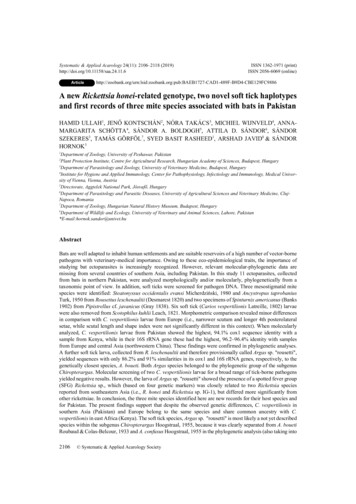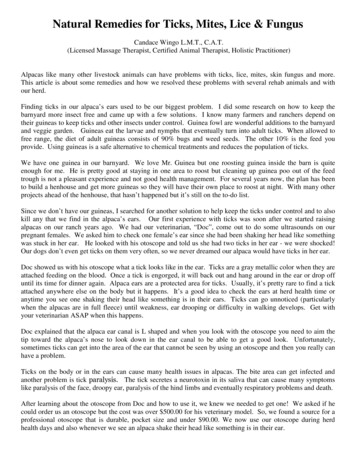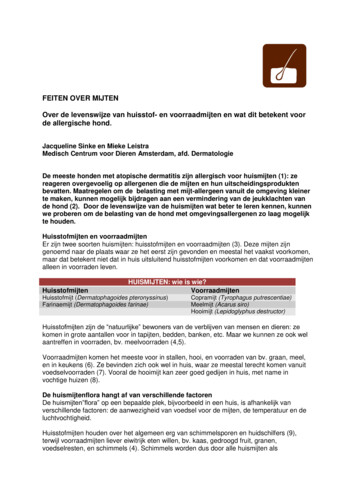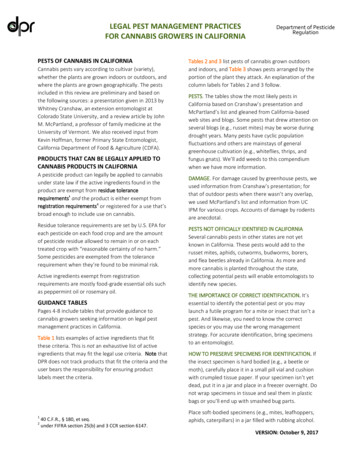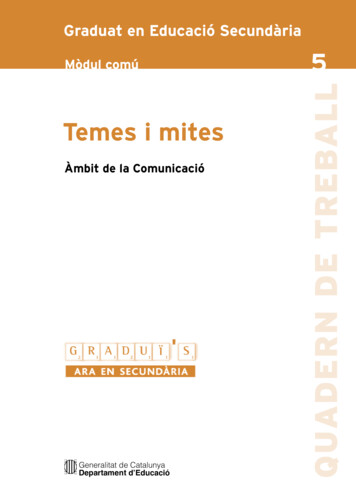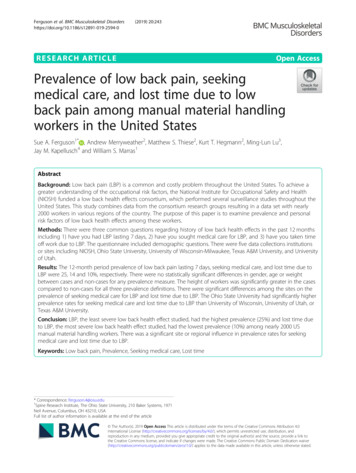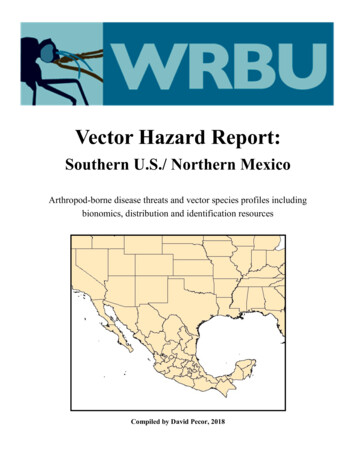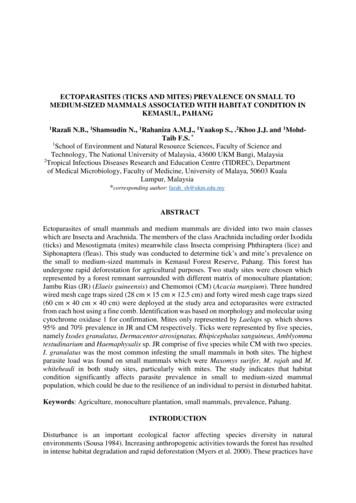
Transcription
ECTOPARASITES (TICKS AND MITES) PREVALENCE ON SMALL TOMEDIUM-SIZED MAMMALS ASSOCIATED WITH HABITAT CONDITION INKEMASUL, PAHANG1RazaliN.B., 1Shamsudin N., 1Rahaniza A.M.J., 1Yaakop S., .2Khoo J.J. and 1MohdTaib F.S. *1School of Environment and Natural Resource Sciences, Faculty of Science andTechnology, The National University of Malaysia, 43600 UKM Bangi, Malaysia2Tropical Infectious Diseases Research and Education Centre (TIDREC), Departmentof Medical Microbiology, Faculty of Medicine, University of Malaya, 50603 KualaLumpur, Malaysia*corresponding author: farah sh@ukm.edu.myABSTRACTEctoparasites of small mammals and medium mammals are divided into two main classeswhich are Insecta and Arachnida. The members of the class Arachnida including order Ixodida(ticks) and Mesostigmata (mites) meanwhile class Insecta comprising Phthiraptera (lice) andSiphonaptera (fleas). This study was conducted to determine tick’s and mite’s prevalence onthe small to medium-sized mammals in Kemasul Forest Reserve, Pahang. This forest hasundergone rapid deforestation for agricultural purposes. Two study sites were chosen whichrepresented by a forest remnant surrounded with different matrix of monoculture plantation;Jambu Rias (JR) (Elaeis guineensis) and Chemomoi (CM) (Acacia mangium). Three hundredwired mesh cage traps sized (28 cm 15 cm 12.5 cm) and forty wired mesh cage traps sized(60 cm 40 cm 40 cm) were deployed at the study area and ectoparasites were extractedfrom each host using a fine comb. Identification was based on morphology and molecular usingcytochrome oxidase 1 for confirmation. Mites only represented by Laelaps sp. which shows95% and 70% prevalence in JR and CM respectively. Ticks were represented by five species,namely Ixodes granulatus, Dermacentor atrosignatus, Rhipicephalus sanguineus, Amblyommatestudinarium and Haemaphysalis sp. JR comprise of five species while CM with two species.I. granulatus was the most common infesting the small mammals in both sites. The highestparasite load was found on small mammals which were Maxomys surifer, M. rajah and M.whiteheadi in both study sites, particularly with mites. The study indicates that habitatcondition significantly affects parasite prevalence in small to medium-sized mammalpopulation, which could be due to the resilience of an individual to persist in disturbed habitat.Keywords: Agriculture, monoculture plantation, small mammals, prevalence, Pahang.INTRODUCTIONDisturbance is an important ecological factor affecting species diversity in naturalenvironments (Sousa 1984). Increasing anthropogenic activities towards the forest has resultedin intense habitat degradation and rapid deforestation (Myers et al. 2000). These practices have
Serangga 23(1):72-88Razali et al.resulted in modified ecosystem that are characterized by a high level of disturbance andhomogeneity (Gentili et al. 2014). Deforestation has brought about habitat loss, resourceexhaustion and subsequently declining in wildlife population. Agriculture has been known asthe major cause of forest loss, having been estimated about 90 per cent of all deforestation inthe tropics (Benhin 2006). Agricultural intensity strongly influences ecosystem service andbiodiversity (Kleijin et al. 2009). In Southeast Asia, the conversion of forest (both primary andlogged) to oil palm agriculture has been uncontrolled (Reynolds et al. 2011).Ticks are easily adapted group of insects that infest the external body surface ofvertebrates (Hanafi-Bojd et al. 2007). Most ticks usually can be found during critical stages ofthe host’s life cycle such as lactation or gestation (Czenze & Broders 2011). Ticks have animportant role in the transmission of a wide range of diseases and a main vector for pathogenicorganisms such as protozoa, rickettsia, bacteria and viruses that can cause zoonotic diseases(Madinah et al. 2011). These organisms cause serious and life-threatening illness in humansand animals (Chul-Min et al. 2006). Large number of ticks’ species used human as intermittenthost. Some ticks parasitize wide variety of hosts, while others are extremely selective and feedsolely on one host species (Oliver 1989). Fever, Rocky Mountain spotted fever and typhusfever are known to be transmitted by ticks (Ansari 1953). Ticks species Dermacentormarginatus also play important role in the epidemiology of the brucellosis (Brucella melitensisand B. abortus) and can even acts as reservoirs of the infective agent (Galuzo & Rementsova1955). The infection persists in the adult ticks at the temperature of the laboratory for 120-150days and declines after 200-300 days. Mites are highly diverse and specialized group that canbe further divided into chiggers, mesostigmatid mites, listrophorids and myobiids (Mohd Zainet al. 2015). Most kinds of mites are free-living; they are not parasitic but a few kinds becomespecialized to feed upon or infest animal (Walter & Proctor 2013). Chiggers are known as avector for scrub typhus disease where Leptotrobidium chiangraiensis and L. deliense are thevector for Orientia tsutsugamushi (Lerdthusnee et al. 2003; Madinah et al. 2011; Weitzel et al.2016). Ornithonyssus bacoti, is mesostigmatid mites that can cause dermatitis in human(Baumstark et al. 2007; Reeves et al. 2007; Rosen et al. 2002).The distribution of ticks and mites are affected by the host’s microhabitat as ticks andmites may encounter other hosts especially when habitats are disturbed, resulting in the changeof the host assemblage (Bittencourt & Rocha 2003). Habitat loss and fragmentation can alsocontribute to disease outbreaks indirectly through the loss of biodiversity (Gentili et al. 2014).It has been suggested that biodiversity plays an important role in decreasing the prevalence ofinfection disease among hosts due to the dilution effect (Ostfeld & Keesing 2000). Hence, thediversity and structure of host communities in different environmental settings can influencetick’s dynamics and the transmission of diseases (Wells et al. 2011), and the presence ofparasite can give important impacts either to host populations or communities (Hudson et al.2006). The distribution of mites can be further classified according to their species ofspecialised; Dermanyssus gallinae and Ornithonyssus sylvarium can migrate from birds tohuman, grain mites and mushroom mites are found in food materials or stored products, chiggermite is found in lawns and open woodlands, while Sarcoptes scabiei and Demodex folliculorumare permanent residents on humans (Dhooria 2016).Small mammals are considered to any non-volant mammals weighing less than 1 kgwhen adult (Barnett & Dutton 1995), while medium-sized mammals weighing less than 5 kg.Rodents, bats and some carnivores fall under the category of small mammals, whereas mediumsized could refer to porcupines, and civets. The skin and its outgrowth form the physicalenvironment in which ticks and mites spend much of their lives and it directly supplies theirISSN 1394-513073
Serangga 23(1):72-88Razali et al.food (Marshall 1981). These mammals play a significant role in maintaining ecosystemfunctionality as seed dispersal agents and arthropod control, and are medically important asreservoirs of zoonotic diseases (Chaisiri et al. 2010; Thanee et al. 2009). Rodents and scandentsare host that can carry many different ectoparasites (Acari and Insecta) (Nadchatram 2008).Rodents are considered as the most important hosts because taxonomically this group had thelargest number of species (Nieri-Bastos et al. 2004).The aim of this study was to determine tick’s and mesotigmatid mite’s prevalence onthe non-volant small to medium-sized in relation to different habitat condition, in KemasulForest Reserve, Pahang. We hypothesized that forest remnant with more disturbed surroundingareas contribute to higher intensity of ectoparasites, as an indication of a stressful condition ofthe animals. Generally, this study can help to gain a better understanding about intensity orprevalence of ticks and mites infestation in relation to habitat condition. Understanding therichness of tick’s species provides valuable insights into the ecological roles they play in theregulation of their host population and communities (Wei et al. 2010). Thus, the managementof hosts can be done effectively to control the spreading of diseases. Information on hostparasite-pathogen interaction is important as it is related to management of zoonotic diseases(Madinah et al. 2014).MATERIAL AND METHODSThe study was carried out in Kemasul Forest Reserve, Pahang (03 22'34.2'' N, 102 16’01.6'' E) (Fig. 1). This forest is lowland dipterocarp forest types, but majority of the areashas been logged to give way for monoculture plantation, such as oil palm. Apart from that,some part of the forest has been converted to forest farm with the plantation of fast-growingacacia trees (Acacia mangium). Sampling was conducted in a long strip of forest fragment withdifferent matrix types; Jambu Rias (JR) with oil palm and Chemomoi (CM) with A. mangiumplantation (Lim et al. 2011) (Fig. 2) from August to November 2015. Kemasul Forest Reservehas an area of 39,000 hectares and was gazetted as forest farm project handled by PahangForestry Department to provide continuous supplication of timbers apart from providing jobsfor farmers in Pahang (Malaysia Auditor General’s Report 2012).A total of three hundred wired mesh cage traps sized (28 cm 15 cm 12.5 cm) andforty wired mesh cage traps sized (60 cm 40 cm 40 cm) were deployed in each study sites.Banana, oil palm fruit and jackfruit were used as bait in the study (Bernard et al. 2004). At eachstudy sites, there were six different trails where fifty wired mesh cage traps sized (28 cm 15cm 12.5 cm) and five wired mesh cage traps sized (60 cm 40 cm 40 cm) were deployedat 5 m interval. The placements of traps were random which located on tree stumps, fallen logs(Balete et al. 2009), and at ground level (Rickart et al. 2011). All traps were checked once dailyat (0900 hrs-1600 hrs). Every individual that have been caught were given anaesthetic injectionusing Zoletil 100 (Massolo et al. 2003) and species identification followed Francis (2008). Allprocedures were approved by The National University of Malaysia Animal Ethic Committeewith approval number ATS.The mammals caught were inspected for ticks and mites by combing with a fine-toothcomb and picking using fine forceps. Each individual of ticks and mites found were preservedin 90% ethanol and stored in labelled individual’s vials. Ticks were brought to the lab forclassification and identification up to genus and species level by using taxonomic keys andpublished pictorial data. Ticks were first sorted into their respective order under dissectingISSN 1394-513074
Serangga 23(1):72-88Razali et al.microscope. The technique for mounting acarines (ticks and mites) followed Mariana et al.2005 and Chuulun et al. 2005. Slides were prepared only for the larval stages as adults can beidentified without mounting. Stereo and compound microscope were used in this study. Theslides were examined under compound microscope (magnification 40x, 100x, 400x, and 100x)for identification. Acarines were identified according to the keys and descriptions given byArthur (1962) and Gullan & Cranston (2010). Mites are brought back to the lab for furtheridentification using molecular procedures. The extraction of DNA was using the DNeasy Blood & Tissue (Qiagen USA) kit. Polymerase Chain Reaction (PCR) was done using COIgene to identify the mite’s individuals up to species level.Data AnalysisPrevalence gives a figure for a factor at single point in time (Jekel et al. 2001). Inepidemiological study, prevalence is a measurement of all individuals affected by the diseaseat a particular time (Shields & Twycross 2003). In this study, overall prevalence of infectedsmall mammals and prevalence of infected small mammals with ectoparasite species X werecalculated.Prevalence of infected small mammals were calculated by using formula:Total no. of infected small mammals 100%Total number of small mammals capturedPrevalence of infected small mammals with ectoparasite species X were calculated by thisformula:Total no. of infected small mammals with ectoparasites X 100%Total no. of infected small mammals with all ectoparasitesRESULTSA total of 30 and 25 individuals of small mammals were captured in JR and CM respectivelythat make the overall total individual of small to medium-sized mammals captured, 55 as shownin Table 1. JR comprised of four families, six genera and eight species. Muridae was thedominant family and represent 66.7% of all individual captured at JR, followed by Sciuridae(10%), Tupaiidae (10%) and Hystricidae (6.7%). Out of eight species, two of them have beenlisted as Vulnerable by the International Union for Conservation of Nature (IUCN) Red List ofThreatened Species, which are Maxomys rajah and M. whiteheadi. CM on the other handrecorded five families, seven genera and 10 species. Muridae was also dominant family foundin both study areas. Maxomys surifer was found to be the most dominant species whichrepresent 20% of total small mammals captured at Chemomoi.From 55 individuals host captured, 32 were infected by ectoparasites where 20 hostwere captured in JR and 12 host were captured in CM (Table 2). Maxomys spp. (M. rajah, M.whiteheadi and M. surifer) were highly infested host in both localities. Leopoldamys sabanusand Hystrix brachyura were infested in JR, meanwhile Rattus rattus and Viverra tangalungawere infested in CM. A total of five species of ticks were identified in both study sites, namelyIxodes granulatus, Dermacentor atrosignatus, Rhipicephalus saguineus, Amblyommatestudinarium and Haemaphysalis sp. Mites was only represented by one species, which wasLaelaps sp. Prevalence of ectoparasite were higher in JR with 67%, compared to CM with 48%.Although JR shows contrastingly higher host infestation compared to CM, Man-Whitney Utest reveal no significant difference between the number of infested host (U 18, z -0.7942,p 0.4271) in both study areas. Similarly, parasite load was higher in JR with 198 individual’sISSN 1394-513075
Serangga 23(1):72-88Razali et al.parasites collected, compared to CM with 79, particularly for mites (Laelaps sp.). Parasite loadof Laelaps sp. was also generally high in several species.Ticks prevalence was slightly higher in JR with 35% compared to CM with 33.3%(Table 3). In JR, the highest prevalence was from Dermacentor atrosignatus and Ixodesgranulatus with 15%. Haemaphysalis sp. was only recorded in single individual in Maxomysrajah, as well as Amblyomma testudinarium which only infest Hystrix brachyura andRhipicephalus saguineus which only infested M. rajah. CM on the other hand, only recorded3 species of ticks, and dominated with Ixodes granulatus (25%) which infested M. surifer, M.whiteheadi whereby and Viverra tangalunga. Next, Dermacentor atrosignatus recorded 8.3%prevalence was found in Rattus rattus and M. surifer respectively.The study reveal that mites only infested specific species in high abundance, namely allMaxomys spp. in both locations while Leopoldamys sabanus also infested with only oneindividuals of mites (Table 3). Prevalence of mites were higher in JR with 95%, compared toCM with 70% (Table 4).DISCUSSIONSThe higher infestation rate in JR and certain species might be attributed to various importantfactors including tick’s distribution, host’s preference, host’s distribution and microhabitat.Ixodes granulatus found to be the dominant species for both study site because this species haswide distribution throughout the continent (Trevor & James 1994). Other species such asDermacentor atrosignatus (Wassef & Hoogstraal, 1984), Rhipicephalus sanguineus (Cooley1946) and Amblyomma testudinarium (Voltzit & Keirans 2002) that was found in the studywas also widely distributed across South-East Asia region. As for Haemaphysalis sp. thatcannot be identified to species level due to lack of keys, however, the distribution of genusHaemaphysalis has its center of distribution in South-East Asia (Petney 1993). The result ofthis study was supported by Mariana et al. (2008) which also recorded three genera of Ixodidticks in non-volant small mammals, similar to this study which were Dermacentor,Haemphysalis, and Ixodes. In general, ticks’ species documented in this study feed on smallmammals, such as Haemaphysalis sp. (Mohd Zain et al. 2015), Ixodes granulatus (Ho &Krishnasamy 1990; Nadchatram et al. 1996) and Amblyomma testudinarium (Voltzit & Keirans2002).Host’s distribution and habitat condition are among the main factor influencing tick’sdistribution (Engelbrecht 2016). According Madinah et al. (2014), the distribution ofectoparasites may have been influenced by the sampling site selection. In this study, JR andCM were surrounded with different matrix types, with oil palm plantation and Acaciaplantation respectively. The distribution of host was higher in JR due to the higher availabilityof food resources compared to CM with less availability of food resource, instead providingbuffer zone for wildlife movement (Razali et. al. unpubl). Some ectoparasites will associatewith hosts of a certain resting site or habitat like whether the area is small or with a distinctenvironment nest, burrows, caves, rock piles, thickets, dense reverine forests, and wet lowlands(Sparagano, 1999). Kitron et al. (1992) found a strong correlation between tick infestation onwhite tailed deer and the occurrence of sandy oil and hardwoods (Ostfeld et al. 1995).According to Zumpt 1961, Laelaps sp. geographically widespread in Sub-saharan Africa.However, there is no current study about this mite’s species in Malaysia or South-east Asia.Mites also have a strong correlation with host’s habitats as recorded in another study by Russoet al. (2010) and Engelbrecht (2016) where Laelaps sp. can be found on two murids hostsISSN 1394-513076
Serangga 23(1):72-88Razali et al.namely Mastomys coucha (grass/ plain dwelling rodent) and Micaelamys namaquensis (rockyhabitats). Members of the parasitc mite genus Laelaps complete majority of their life cycle inthe nest of the host (Radovsky 1994). It is evident that habitat disturbance may increase theprevalence of hosts and ectoparasites and affect the structure of small mammal’s communities(Madinah et al. 2014), and therefore, induce parasite host-switches (Wells et al. 2007). Loss ofbiodiversity will occur due to the highly-fragmented landscape (Blake & Karr 1987) thusreduces the abundance of parasite-hosts and lead to another factor such as limited area fordispersal and survival of ticks on smaller patches (Werden 2012).Maxomys whiteheadi had the highest prevalence of Ixodes granulatus especially in JR.Madinah et al. (2014) use network analysis to determine the host specialization of ticks, inorder to observe patterns of parasites and their hosts (Poulin 2010). Like non-volant smallmammals, ectoparasites also can be divided to specialist and generalist depends on its host.Most species in genus Ixodes are generally host specific (Mccoy et al. 2013) except Ixodesgranulatus and I. ovatus (Petney 1993). Thus, the distribution of ticks is tightly linked to theecological characteristics of the host such as host’s microhabitat (Mccoy et al. 2013). On theother hand, Laelaps sp. tend to be rodent generalist mites such as found in Maxomys rajah, M.whiteheadi, M. surifer and Leopoldamys sabanus. This result was supported by Zumpt (1961)who reported infestation of Laelaps sp. from multiple rodent species in Sub-saharan Africa.Other mite’s species such as Laelaps giganteus is a host specific mite which occurs on the fourstripped mouse genus Rhabdomys in southern Africa (Matthee et al. 2007).Other factors that contribute to higher infestation rate in JR are host’s sex, body mass,and size of body’s host. These factors are interrelated in affecting infestation rate ofectoparasite. Usually male hosts have higher body mass and larger body size compared tofemale host. Large body mass resulted in large size of host. Many studies showed that thegreater the size of the animal may provide a greater surface for ectoparasites to attached due togreater area it will sweep (Arneberg et al., 1998; Milne 1949; Mysterud et al. 2015). This studyshowed that most of the small to medium size mammals captured which weighted more than10g threshold (Mysterud et al. 2015) have infested by ectoparasites. Similar to this study, otherstudies explained that increasing body mass of host will increase the ectoparasites loads(Mysterud et al. 2015; Perkin et al. 2003). This statement explained some of the species in thisstudy such as Maxomys rajah, M. whiteheadi and M. surifer at JR have high ectoparasites loadson them as shown in Table 2.However, medium-sized mammals in this study which were female Hystrix brachyuraand female Viverra tangalunga had the least number of tick’s load. Both females are assumedlactating due to its morphological and have young. Typically, female mammals and theiryoung’s self-groomed and groomed their young at a higher rate. In behavioural study ofImpala, (Aepyceros melampus) have observed that both young and their mothers areconsistently groomed have low ticks load (Hart et al. 1992). Thus, the infestation rates of tickson small mammals can serves as ecological labels related to the patterns of distribution andbehaviour of the host (Audy 1954).Out of six species of ticks, four of them were reported as vector for Rickettsiae thatcaused spotted fever which are Haemaphysalis sp., Dermacentor atrosignatus and Ixodesgranulatus (Marchette, 1965). Ixodes granulatus is also a vector of Langat Virus (Smith 1956)and is involved in the cycle of tick typhus and Q fever in Peninsular Malaysia (Marchette 1965).Langat Virus is similar to Russian Spring-Summer Encephalitis Complex (RSSE) and was firstrecognized in 1956 in Ixodes granulatus infesting Sundamys muelleri and LeopoldamysISSN 1394-513077
Serangga 23(1):72-88Razali et al.sabanus (Madinah et al. 2011). Apart from that, Rhipicephalus sannguineus is responsible forthe transmission of Babesia gibsoni, to dogs in this region as well as other parts of the world(Mokhtar et al. 2013). However, there is still no further study on Laelaps sp. as a vector forzoonotic disease.CONCLUSIONIn conclusion, this study indicates that habitat condition will significantly affect parasiteprevalence in small to medium-sized mammal population. Factor that greatly caused this couldbe due to the resilience of an individual to persist in disturbed habitat. It is also important tounderstand the links between prevalence and rate of infestation of ectoparasites to predict tickpopulation dynamics and epidemiology of tick-borne disease. This study can also serve as thestepping stone to create awareness among public on the tick-borne disease for a betterprevention control program.ACKNOWLEDGEMENTWe would like to thank Department of Wildlife and National Parks (DWNP) to conduct thisresearch at Kemasul, Pahang. Our sincere appreciation to DWNP staff for their assistanceduring sampling. We also want to extend our gratitude to Tenaga Nasional Berhad Researchfor providing research grant to conduct this research under research code ST 2015-001.ISSN 1394-513078
Serangga 23(1):72-88Razali et al.REFERENCESAnsari, M.A. 1953. The rat ectoparasites, their role as vector of human diseases and theircontrol. Pakistan Journal of Health 3(2): 95-100.Arneberg, P., Skorping, A. & Read, A.F. 1998. Parasite abundance, body size, life historiesand the energetic equivalence rule. The American naturalist 151(6):497-513.Arthur, D.R. 1962. Ticks and Disease. 1st Edition. Oxford: Pergamon Press.Audy, J.R. 1954. Malaysian parasites IX: notes on taxonomy of Trombiculid mites withdescription of a new subgenus. Stud. Inst Med. Res. Malaya 26:123-170.Balete, D.S., Heaney, L.R., Josefa Veluz, M. & Rickart, E.A. 2009. Diversity patterns of smallmammals in the Zambales Mts., Luzon, Philippines. Mammalian Biology - Zeitschriftfür Säugetierkunde 74(6):456–466.Baumstark, J., Beck, W. & Hofmann, H. 2007. Outbreak of tropical rat mite (Ornithonyssusbacoti) dermatitis in a home for disabled persons. Dermatology 215(1):66-68.Barnett, A. & Dutton, J. 1995. Expedition field techniques: Small mammals (excluding bats).Journal of Tropical Ecology 12(3):408-534.Benhin, J.K.A. 2006. Agriculture and deforestation in the tropics: A critical theoretical andempirical review. Ambio 35:9-16.Bernard, H., Mohd. Yusah, K., Yasuma, S. & Kimsui, L. 2004. A survey of the non-flyingsmall mammals at several elevations and around Crocker Range Park. Crocker RangeScientific Expedition 2002:113–130.Blake, J.G. & Karr, J.R. 1987. Breeding birds of isolated woodlots: Area and habitatrelationships. Ecology 68:1724-1734.Bittencourt, E.B. & Rocha, C.F.D. 2003. Host-ectoparasite specificity in a small mammalcommunity in an area of Atlantic rain forest (Ilha Grande, State of Rio de Janeiro),Southeastern Brazil. Memorias Do Instituto Oswaldo Cruz 98(6): 793–798.Chaisiri, K., Chaeychomsri, W., Siruntawineti, J., Bordes, F., Herbreteau, V. & Morand S.2010. Human-dominated habitats and helminth parasitism in Southeast Asian murids.Parasitology Research 107:931-937.Chul-Min, K., Ying-Hua, Y. & Do-Hyeon, Y. 2006. Tick-borne Rickettsial pathogens in ticksand small mammals in Korea. Appl. Environ. Microbiol. 72: 5766-5776.Chuluun, B., Mariana, A., Ho, T. & Mohd Kulaimi, B. 2005. A preliminary survey ofectoparasites of small mammals in Kuala Selangor Nature Park. Trop. Biomed. 22:243247.ISSN 1394-513079
Serangga 23(1):72-88Razali et al.Cooley, R.A. 1946. The Genera Boophilus, Rhipicephalus, and Haemaphysalis (Ixodidae) ofThe New World. Washington: U.S. Govt. Print. Off.Czenze, J.Z. & Broders, H.G. 2011. Ectoparasite community structure of two bats (Myotislucifugus and M. septentrionalis) from the Maritimes of Canada. Journal ofParasitology Research 2011:1-9.Dhooria, M.S. 2016. Medical and veterinary. In. Dhooria, M.S. (Ed.). Fundamental of AppliedAcarology, pp. 425-439. Singapore: Springer.Engelbrecht, A. 2016. Phylogeography of the rodent mites Laelaps giganteus and Laelapsmuricola using mitochondrial and nuclear DNA markers: An evolutionary approach tohost-parasite interactions. Ph.D thesis. Stellenbosch University, South Africa.Francis, C.M. 2008. A field guide to the mammals of South-East Asia. 2nd Edition. London:New Holland.Galuzo, I.G. & Rementsova, M.M. 1955. Reservoirs of animal Brucellosis amongst wildanimals and birds, in the light of studies of foci of infection. Trudy Inst. Zool. Alma-Ata3:12-26.Gentili, S., Sigura, M. & Bonesi, L. 2014. Decreased small mammal’s species diversity andincreased population abundance along a gradient of agricultural intensification. Hystrix,the Italian Journal of Mammalogy 25(1):39–44.Gullan, P.J. & Cranston, P.S. 2010. The insects an outline of entomology. United Kingdom:Chapman and Hall.Hanafi-Bojd, A.A., Shahi, M., Baghaii, M., Shayeghi, M., Razmand, N. & Pakari, A. 2007. Astudy on rodent ectoparasites in Bandar Abbas: The main economic southern seaport ofIran. Iranian J. Envir. Health Sci. Engin. 4:173-176.Hart, B.L., Hart, L.A., Mooring, M.S. & Olubayo, R. 1992. Biological basis of groomingbehaviour in antelope: The body-size, vigilance, and habitat principles. AnimalBehaviour 44(4):615-631.Hudson, P.J., Dobson, A.P. & Lafferty, K.D. 2006. Is a healthy ecosystem one that is rich inparasites? Trends. Ecol. Evol. 21:381-385.Ho, T.M. & Krishnasamy, M. 1990. Ectoparasites acari and endoparasites of small mammalsin Taman Negara. J. Wildlife Parks 10:54-61.Jekel, J.F., Katz, D.L., Elmore, J.G. & Wild, D. 2001. Epidemiology, Biostatistics, andPreventive Medicine. 2nd Edition. Philadelphia: WB Saunders.Kitron, U., Jones, C.J., Bouseman, J.K., Nelson, J.A. & Baumgartner, D.L. 1992. Spatialanalysis of the distribution of Ixodes damini (Acari: Ixodidae) on white tailed deer inOgle country Illinois. J. Med. Entomol. 29:259-266.ISSN 1394-513080
Serangga 23(1):72-88Razali et al.Kleijin, K., Kohler, F., Baldi, A., Batary, P., Concepcion, E.D., Clough, Y., Diaz, M., Gabriel,D., Holzschuh, A. & Knop, E. 2009. On the relationship between farmland biodiversityand land-use intensity in Europe. Proc. R. Soc. B. 276:903-909.Lacombe, E.H., Rand, P.W. & Smith, R.P. 1999. Severe reaction in domestic animals followingthe bite of Ixodes muris (Acari: Ixodidae). Journal of Medical Entomology 36(3): 227–232.Lerdthusnee, K., Khuntirat, B., Leepitakrat, W., Tanskul, P., Monkanna, T., Khlaimanee, N.,Inlao, I., Kengluecha, A., Mungviriya, S., Chandranoi, K., Krairojananan, P.,Bodhidatta, D., Rodkwamthook, W., Phulsuksombati, D., Sangjun, N.,Watcharapichat, P., Jones, J.W. & Coleman, R.E. 2003. Scrub typhus. Annals of theNew York Academy of Sciences 990: 25–35.Lim, S.C., Gan, K S. &Tan, Y.E. 2011. Properties of Acacia mangium planted in PeninsularMalaysia: ITTO Project in Proving Utilization and Value Adding of Plantation Timbersfrom Sustainable Sources in Malaysia. Kepong: Forest Research Institute Malaysia.Loveridge, R. 2012. Microhabitat preference of native and invasive small mammal species inlogged forests of Sabah, Borneo. MSc thesis. Imperial College London, London.Madinah, A., Fatimah, A., Mariana, A. & Abdullah, M.T. 2011. Ectoparasites of smallmammals in four localities of wildlife reserves in Peninsular Malaysia. Southeast AsianJournal of Tropical Medicine and Public Health 42(4): 803–813.Madinah, A., Abang, F., Mariana, A., Abdullah, M.T. & Mohd-Azlan, J. 2014. Interaction ofectoparasites small mammals in tropical rainforest of Malaysia. Community Ecol. 15(1):113-120.Marchete, N.J. 1965. Rickettsiosis (tick typhus, Q-fever, urban -typhus in Malaya.) Journal ofMedical Entomology 2: 339-371.Malaysia Auditor General’s Report. 2012. The Activities of Department
ECTOPARASITES (TICKS AND MITES) PREVALENCE ON SMALL TO MEDIUM-SIZED MAMMALS ASSOCIATED WITH HABITAT CONDITION IN KEMASUL, PAHANG 1Razali N.B., 1Shamsudin N., 1Rahaniza A.M.J., 1Yaakop S., .2Khoo J.J. and 1Mohd- Taib F.S. * 1School of Environment and Natural Resource Sciences, Faculty of Science and Technology, The National University of Malaysia, 43600 UKM Bangi, Malaysia
